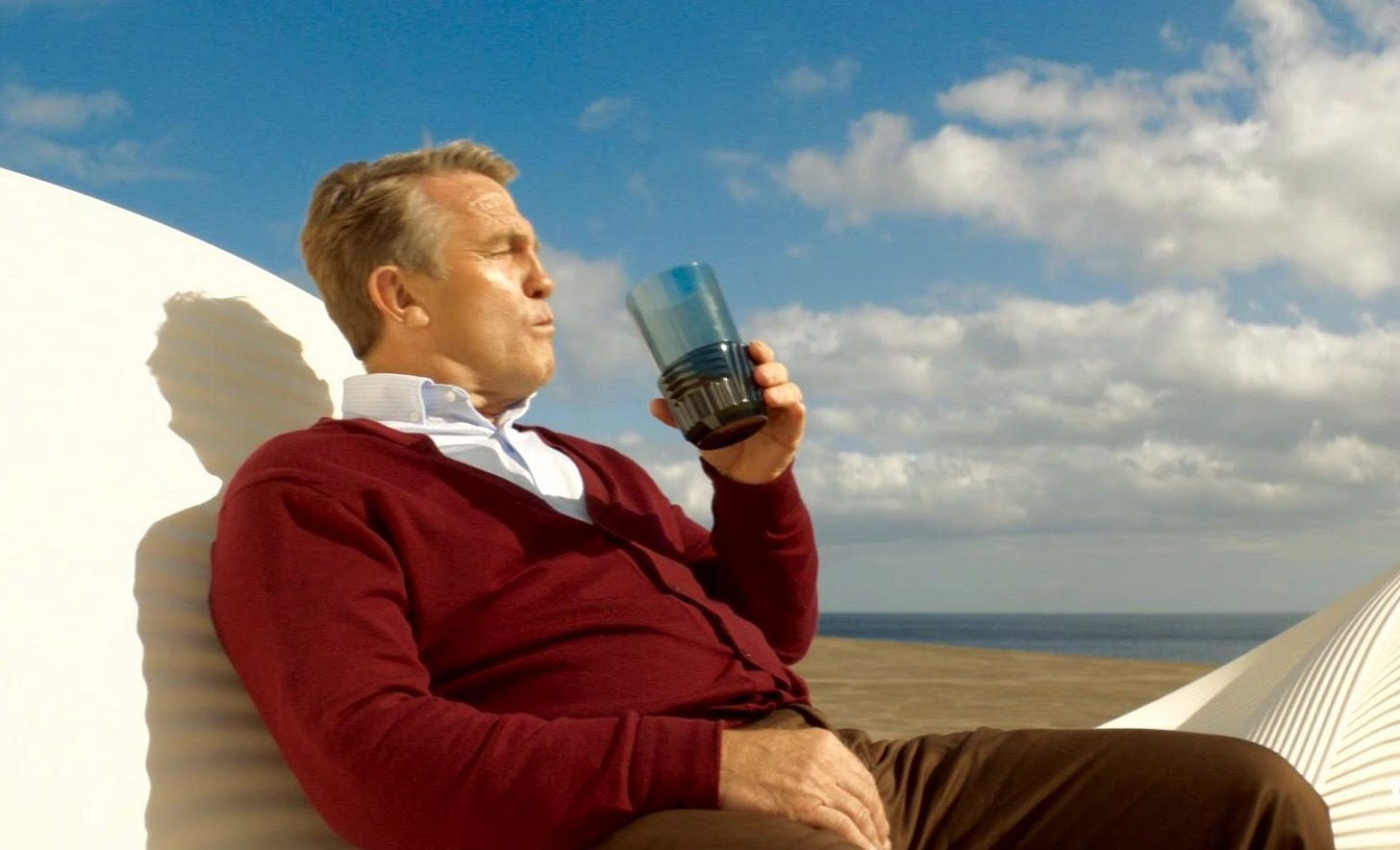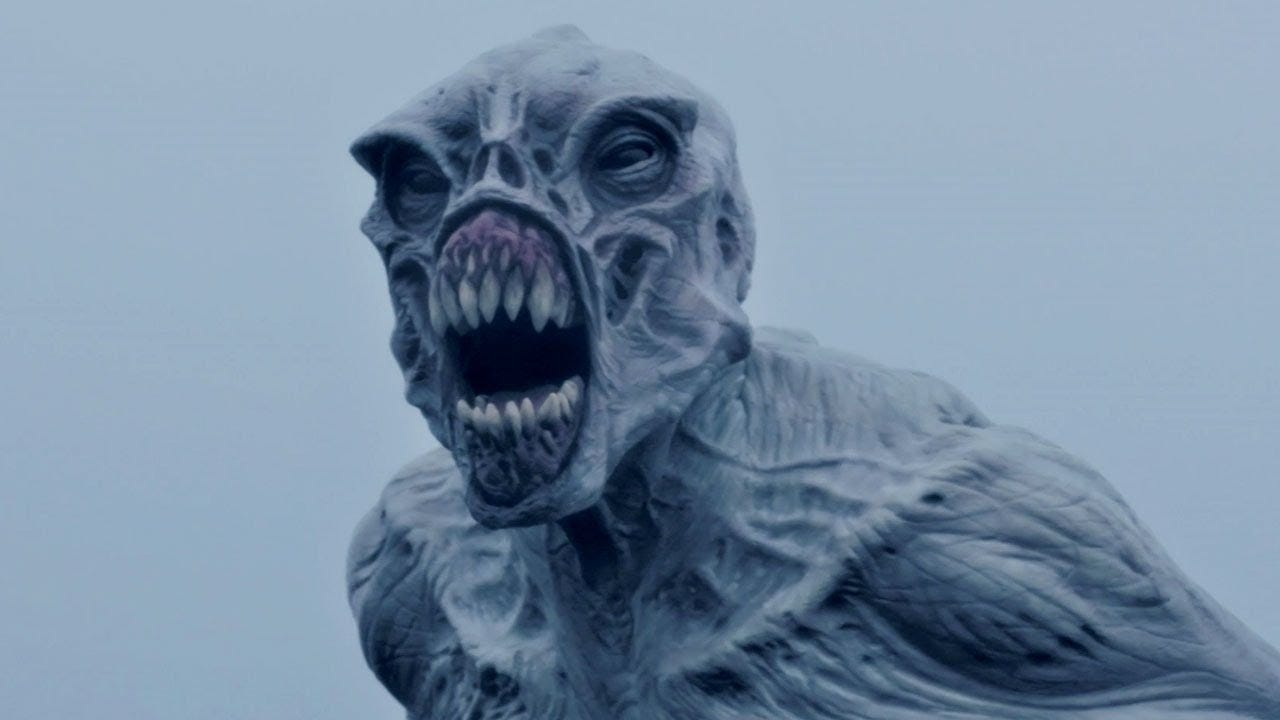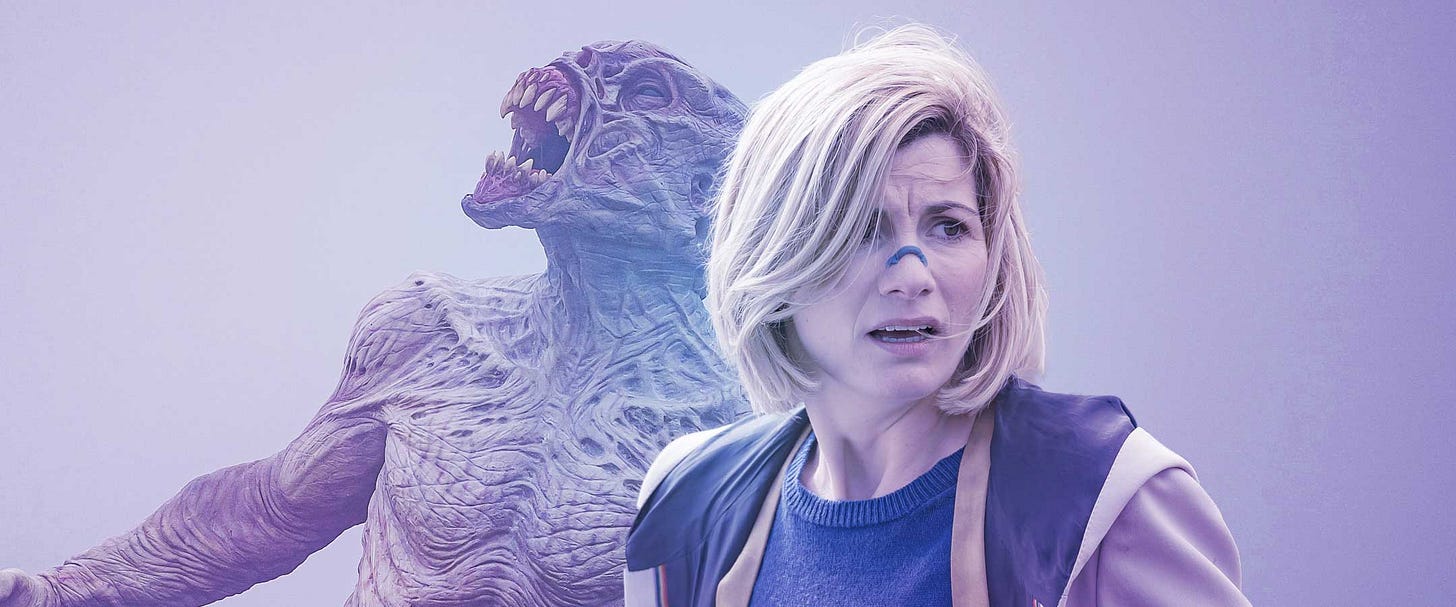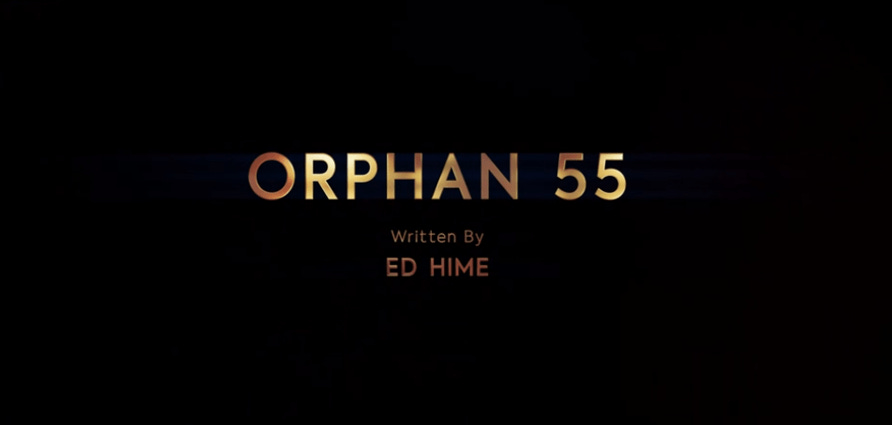Doctor Who
“Orphan 55”
Series 12, Episode 3
Written by Ed Hime
Directed by Lee Haven Jones
Starring Jodie Whittaker, Tosin Cole, Mandip Gill, and Bradley Walsh
Guest Starring Amy Booth-Steel, Laura Fraser, and Gia Ré
46 minutes
Original broadcast 12 January 2020
1. Dusk
With “Orphan 55,” Doctor Who declares itself a program not merely worried about, but appalled by the climate crisis.
Series 11 did so, as well, in its fourth episode, “Arachnids in the UK” (written by showrunner Chris Chibnall), while previous entries dramatize the complex relationships between humanity and its earthly environments—see Series 1’s “The End of the World” (written by then-showrunner Russell T. Davies), Series 4’s two-parter “The Sontaran Stratagem” / “The Poison Sky” (both written by Helen Raynor), and Series 8’s “In the Forest of the Night” (written by Frank Cottrell-Boyce).
Yet “Orphan 55” takes the most despairing stance of any New Who episode thus far, coming as close to depressive desolation as the program ever gets.
This reality perhaps explains why “Orphan 55,” at least according to its Internet Movie Database (IMDb) user rating, is Doctor Who’s least-liked installment since the show returned to television in 2005 (receiving a paltry 4.2 on IMDb’s ten-point scale). Some fans give this Ed Hime-scripted outing such scorched-earth reviews that, reading them, we might think the episode preaches about the need to take care of our planet so baldly (and so badly) that we should skip this one altogether.
Anyone put off by such opinions should hazard the journey anyway. What will they find? An intense, grim, and perversely exciting hour of television that recalls one of New Who’s most beloved installments: Series 4’s “Midnight” (written by Russell T. Davies in only six days1). Yes, friends, “Orphan 55” at one point sees the Thirteenth Doctor (Jodie Whittaker) and her intrepid companions—Ryan Sinclair (Tosin Cole), Yasmin “Yaz” Khan (Mandip Gill), and Graham O’Brien (Bradley Walsh)—trapped in a motorized armored vehicle (i.e., a tank) being assaulted by frightening creatures whose motives seem absolutely alien to the tank’s human (and humanoid) occupants.
This scenario, of course, reminds careful viewers of the Tenth Doctor’s (David Tennant’s) unforgettable “Midnight” trip in a touring bus/tank named Crusader 50. Setting out from a posh resort dropped from orbit onto the surface of the diamond-encrusted planet Midnight, Crusader 50 breaks down midway through the trip, leaving the Tenth Doctor and the bus’s seven human occupants to endure the attacks of an unseen, non-corporeal creature that possesses the body of one traveller and that, by repeating verbatim every person’s words, brings this group to the point of murderous madness.
“Midnight” begins as a lighthearted romp that turns into a dystopian unveiling of human paranoia and prejudice so penetrating in its psychological horror that the mere act of reading Davies’s script2 raises one’s hackles as high as they can go. Seeing this teleplay dramatized onscreen by the episode’s superb cast and by its marvelous director, Alice Troughton, becomes an indelible experience.
“Orphan 55,” in what must be deliberate echoes of “Midnight,” begins by seeing Graham finding six coupons (published in the interstellar newspaper Bandohzi Herald) that grant Team TARDIS free vacations at Tranquility Spa, to which our cosmic travelers are instantly teleported. This resort, in fact, does the spa in “Midnight” one better by including every imaginable amenity, a fact that compels the Doctor to explore the facility while her companions enjoy Tranquility’s many pleasures.
Thanks to impressive production design by Dafyyd Shurmer and crackerjack cinematography by Ed Moore, Tranquility is an over-the-top version of every luxury resort you’ve ever seen advertised in newspapers, in magazines, and on game shows: welcoming in its massive-yet-sterile architecture, full of helpful-if-not-obsequious staff members (especially Amy Booth-Steel’s chipper, human-animal hybrid Hyph3n—“with a three,” she helpfully notes), bathed in brilliant sunlight, and located in an out-of-the-way place that assures guests won’t be bothered by pesky locals or other unwelcome visitors.
Graham, Yaz, and Ryan are stunned by these palatial surroundings, but if this description sounds too good to be true, well, dear reader, the Doctor shares your suspicions. She goes on the hunt after a vending machine gives Ryan a shock that transmits a “hopper virus” into his bloodstream that, left untreated, will mutate into a neurological toxin.
The fact that a simple machine can pass its sickness to human beings may have seemed innovative—and even innocent—when “Orphan 55” first premiered on 12 January 2020, with reports about a mysterious virus emanating out of Wuhan, China sporadically dotting our newsfeeds, but upon revisiting this episode after enduring months of COVID-19 lockdowns, this small detail—what screenwriters sometimes call the “inciting incident” that sets characters onto the adventure that occupies them for the remainder of the production’s running time—hits with much greater (and ghastlier) force than it did upon initial broadcast.

2. Nightfall
The Doctor’s fun, even flippant, way of dealing with Ryan’s sickness, a multistep farce that concludes by having Ryan suck his thumb, may seem tin-eared in light of COVID-19’s real-world depredations, but in truth underscores just how well Ed Hime and Chris Chibnall know how to dramatize the dreadful havoc that ecological devastation can wreak on our world (even if they didn’t intend such prescience while conceiving, discussing, and writing “Orphan 55’s” early drafts). The Doctor suspects that Tranquility Spa is, indeed, a sinister locale rather than a relaxing vacation spot and, when she discovers a control room staffed by two beleaguered workers trying to keep the place from falling apart, she’s chagrined to realize that her suspicions are—to coin a phrase—dead-on.
Unlike “Midnight,” however, the guest characters that populate “Orphan 55” aren’t nearly as distinct, memorable, or complex as Russell T. Davies makes his episode’s guest cast despite Hime’s valiant attempts to people his motley crew with complicated personalities. This failing is especially regrettable given the talented performers playing these roles, foremost among them Laura Fraser as Tranquility Spa’s owner, Kane, and and Gia Ré as her estranged daughter, Bella. The hostility between these two women promises far more than Hime can deliver in 46 minutes of onscreen drama, leaving Fraser and Ré to make their mother-daughter tensions more than the sum of their clichéd parts.
As an intimate character study of people overwhelmed by daunting physical and psychological obstacles, “Orphan 55” cannot hope to match “Midnight’s” nuance, insight, or quality. Anyone hoping that Hime’s “Orphan 55” scribblings will repeat the glories of Davies’s matchless “Midnight” writing will be so disappointed that even entertaining the notion that Hime and Chibnall conceived this installment to stir memories of “Midnight” seems a spectacular misfire.
Yet, in execution, “Orphan 55” wrings as much uncertainty, paranoia, and terror out of its characters (and its audience members) as “Midnight” by including creatures so horrifying that revulsion is the first (and, perhaps, only) response to seeing their vicious, snarling, razor-toothed visages.
This reaction is a credit to the hard work of Doctor Who’s creature-design, makeup, and stunt teams that takes us backward, into the era of 1940s’ and 1950s’ cinematic science fiction, where nearly all extraterrestrials were monstrous threats to humanity’s survival. Even so, Hime and Chibnall pull the dramatic rug from underneath us by revealing that these creatures are, in fact, the human inhabitants of a far-future Earth whose environmental degradation is so pronounced that natural selection forces evolutionary metamorphoses that may be sickening, but that the Doctor and Yaz refuse to credit as terrible (or even negative).
An orphan planet, the Doctor explains, is “a grading that means it’s become too toxic for life,” but this notion is wrong insofar as mutated human beings do, indeed, survive to menace the spa’s guests. Kane dubs these creatures Dregs to illustrate how Hime and “Orphan 55” disregard thematic subtlety in favor of hammering home their point: global warming and nuclear devastation so warp Earth’s environment that evolution repays humanity’s deplorable treatment of its home planet by making us unrecognizable, ferocious, ravening beasts.

Tranquility Spa’s name, therefore, is both the summit and the nadir of irony. Team TARDIS discovers that this resort occupies land near the former Russian city of Novosibirsk when, while evading a Dreg attack, they flee into underground tunnels that reveal themselves to be old Siberian railway lines. This sequence demonstrates a dramatic maturity that “Orphan 55” achieves covertly, at least as far as this installment’s haters are concerned, by indicting the high-handed, First-World attitudes of tourists who visit perfectly appointed vacation spots built in the midst of grinding poverty (i.e., tourists who sniff and snarl at the destitution surrounding their antiseptic, walled-off quarters while doing nothing to alleviate it).
The fact that Kane deliberately locates Tranquility Spa in the middle of Dreg territory hoping to earn massive profits—forcing her to enclose the resort inside screens onto which she projects picturesque landscapes that hide Orphan 55’s surface devastation—prosecutes the case against human cupidity, venality, and stupidity far better than Kane’s plan to bequeath Tranquility Spa to Bella, who hates her mother so much that she (Bella) plants the hopper viruses and small bombs that eventually breach the spa’s defenses. This parent-child dysfunction simply doesn’t work, either as text or subtext, leaving Laura Fraser and Gia Ré to salvage what they can from the mishmash of recrimination, anger, and misunderstood motives that Hime’s teleplay gives them.
That they equate themselves so well is a tribute to each woman’s efforts, to say nothing of director Lee Haven Jones’s firm grasp of this episode’s dramatic possibilities. Fraser, best known to American audiences for playing Lydia Rodarte-Quayle in Vince Gilligan’s Breaking Bad (and its spinoff / prequel Better Call Saul), is a terrific Scottish actress whose extensive stage, film, and television credits ensure an excellent performance.
Ré (also known as Gia Lodge-O’Malley) is nearly Fraser’s equal, etching a memorable portrait of daughterly resentment that overcomes her character’s severely underwritten intentions. Despite such plaudits, these nicely calibrated performances can’t obscure their characters’ one-dimensional status despite Hime’s attempts at nuance, so we must charge Hime (and Chibnall), at least in these instances, with authorial malpractice.

3. Daybreak
All, however, is not lost. “Orphan 55” concludes with the Thirteenth Doctor addressing not merely her companions, but all audience members, by reminding them that the terrible sights they’ve just witnessed come from only “one possible future,” which begins to explain how such devastation could develop despite no previous incarnation having encountered (or even mentioning) it.
Indeed, when considering how the Ninth Doctor tells his companion, Rose Tyler (Billie Piper), in the early moments of New Who’s second installment (the previously mentioned “The End of the World”), “You lot, you spend all your time thinking about dying, like you’re going to get killed by eggs or beef or global warming or asteroids. But you never take time to imagine the impossible, that maybe you survive,” the fact that Orphan 55 (the planet) and “Orphan 55” (the episode) exist at all means that some timey-wimey contradictions must be resolved.
Yet little explanation is necessary. As the Ninth Doctor notes in the closing moments of “The End of the World,” “You think it’ll last forever, people and cars and concrete, but it won’t. One day it’s all gone. Even the sky,” which suggests that “Orphan 55” doesn’t diverge from Who’s generally optimistic vision of humanity surviving into the distant future as much as it might appear. Plus, the Thirteenth Doctor’s final words in “Orphan 55” call us to action:
Look, I know what you’re thinking. But it’s one possible future. It’s one timeline. You want me to tell you that Earth’s going to be okay? ‘Cause I can’t. In your time, humanity’s busy arguing over the washing-up while the house burns down. Unless people face facts and change, catastrophe is coming. But it’s not decided. You know that. The future is not fixed. It depends on billions of decisions, and actions, and people stepping up. Humans, I think you forget how powerful you are. Lives change worlds. People can save planets or wreck them. That’s the choice. Be the best of humanity.
These lines—well delivered, as always, by Jodie Whittaker—have raised howls of protest from New Who fans who find them too on-the-nose, too political, and too preachy. Who needs sermons when light entertainment—a jot of harmless prattle on Sunday evening—is preferable to listening to the Doctor lecture us about impending climatological doom?
I admire the fact that, in the end, Hime and Chibnall don’t care about this understandable criticism, but lurch ahead with an environmental homily that recalls Classic Who’s earliest pedagogical mission: to teach audience members, especially younger viewers, about history and about our responsibilities as participants in that history to do good in our daily lives.
When Russell T. Davies wrote “The End of the World” in 2004, global warming was a massive threat, but still seemed distant enough that we could (and would) deal with it. When Ed Hime wrote “Orphan 55” in 2019, the dire predictions of Naomi Oreskes; Bill McKibben; young activists like Xiye Bastida, Mari Copeny, and Greta Thunberg; and the United Nations’ Intergovernmental Panel on Climate Change hadn’t simply come true, but were worse than previously imagined. So I, for one, don’t mind Doctor Who shaking us by the lapels every now and again, particularly in service of such an urgent, timely, and necessary message.
“Orphan 55,” in other words, isn’t peak Doctor Who, but it is a peak example of a certain type of Who outing: explicitly educational—didactic, even pedantic—in tone, and not at all afraid of being called political. As drama, it works only three-quarters of the time, but I begrudge neither this installment’s motives nor its cast’s and crew’s good work and good intentions.
This judgment may seem a backhanded compliment, but “Orphan 55” is finer than its harshest detractors admit, even if you must watch it more than once to arrive at this conclusion. Viewers who refuse this voyage have my sympathies, but I encourage you, dear reader, to take the trip anyway. It will be better—not necessarily more pleasant, but better—than you’ve heard.
FILES
NOTES
Although more than one New Who behind-the-scenes legend about “Midnight” (to say nothing of its IMDb “Trivia Page”) claims that Davies wrote this installment’s script in only three days, Davies’s email correspondence with Doctor Who Magazine reporter Benjamin Cook, collected in their invaluable book The Writer’s Tale: The Final Chapter (BBC Books, 2010), demonstrates that Davies began “Midnight’s” script on 13 October 2007 and finished its first draft on 18 October 2007.
Read the full teleplay here (https://www.bbc.co.uk/writers/documents/doctor-who-4-episode-10-midnight-pink-revisions-27112007.pdf). Davies’s script, among the finest texts written for any medium during the 21st Century’s inaugural decade, remains an indispensable teaching tool for creative-writing courses and workshops (particularly screenwriting courses) at both the high-school and university levels.






I like the entertainment value of this, Jason. Perhaps the take-home phrase here is: "crackerjack cinematography." Something about it is very efficiently and viscerally written--so this is a lovely read. Hope you're well this week? Cheers, -Thalia